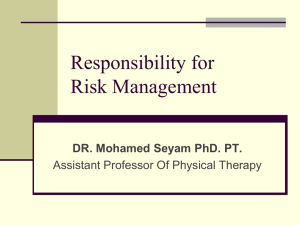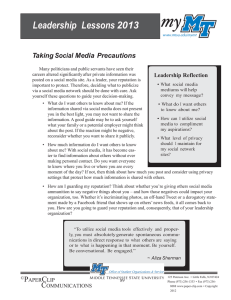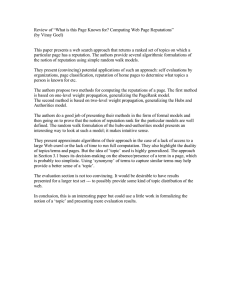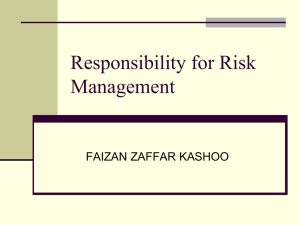ART Testbed Join the discussion group at: -testbed.net
advertisement
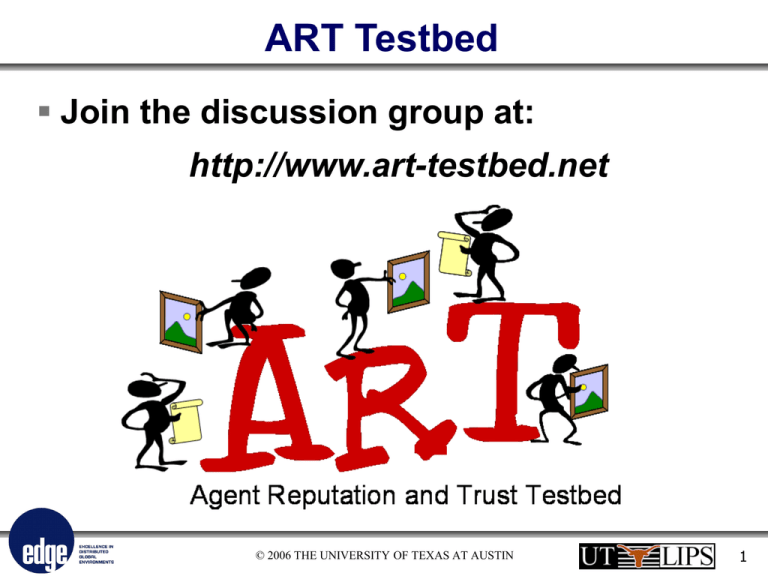
ART Testbed Join the discussion group at: http://www.art-testbed.net © 2006 THE UNIVERSITY OF TEXAS AT AUSTIN 1 ART Testbed Questions Can agents request reputations about themselves? Can an agent produce an appraisal without purchasing opinions? Does the Testbed assume a common representation for reputations? Does the Testbed prevent agents from winning via action-planning skills, as opposed to trust-modeling skills? What if an agent can’t or won’t give a reputation value? Why does it cost more to generate an accurate opinion than an inaccurate one? Why not have a centralized reputation broker? Isn’t it unrealistic to assume a true value of a painting can be known? Is art appraisal a realistic domain? Why not design an incentive-compatible mechanism to enforce truth-telling? © 2006 THE UNIVERSITY OF TEXAS AT AUSTIN 2 “Really Good” ART Testbed Questions Is there a consensus on the definitions of “trustworthiness” and “reputation”? How can collusion be avoided? Is truth-telling a dominant strategy? Will the system reach equilibrium, at which point reputations are no longer useful? What happens if client fee (100), opinion cost (10), and reputation cost (1) are changed? Do any equilibria exist? What happens when agents enter or leave the system? When will agents seek out reputations? Space of experiments is underexplored—that’s a good thing! © 2006 THE UNIVERSITY OF TEXAS AT AUSTIN 3 Questions about the Paper What is a “trust model”? How does q-learning work? How related to reinforcement learning? How do rewards tie in? What is lambda? How can experience- and reputation-based learning be combined to overcome the weaknesses of each (intermediate lambda values)? What about different combinations of (more sophisticated) agents in a game? Why the assumptions chosen? They seem too extreme. Reputation decisions weren’t examined very well. © 2006 THE UNIVERSITY OF TEXAS AT AUSTIN 4 The Agent Reputation and Trust Testbed: Experimentation and Competition for Trust in Agent Societies Karen K. Fullam1, Tomas B. Klos2, Guillaume Muller3, Jordi Sabater4, Andreas Schlosser5, Zvi Topol6, K. Suzanne Barber1, Jeffrey S. Rosenschein6, Laurent Vercouter3, and Marco Voss5 1Laboratory for Intelligent Processes and Systems, University of Texas at Austin, USA for Mathematics and Computer Science (CWI), Amsterdam, The Netherlands 3 Ecole Nationale Superieure des Mines, Saint-Etienne, France 4Institute of Cognitive Science and Technology (ISTC), National Research Council (CNR), Rome, Italy 5IT Transfer Office, Darmstadt University of Technology, Darmstadt, Germany 6Multiagent Systems Research Group—Critical MAS, Hebrew University, Jerusalem, Israel 2Center Testbed Game Rules If an appraiser is not very knowledgeable For a fixed price, clients Agents functionabout as a painting, it can ask appraisers to provide purchase "opinions" art appraisers with appraisals of paintings from varying expertise in other appraisers. from various eras. different Appraiserartistic eras. Agent Client Client Appraiser Agent Opinions and Reputations Client Clientwhose Share Appraisers appraisals are more accurate receive larger shares of the client base in the future. The Agent Reputation and Trust Testbed, 2006 Appraiser Agent Appraiser Agent Appraisers can also buy and sell reputation information about other Appraisers compete toappraisers. achieve the highest earnings by the end of the game. Appraiser Agent Step 1: Client and Expertise Assignments Appraisers receive clients who pay a fixed price to request appraisals Client paintings are randomly distributed across eras As game progresses, more accurate appraisers receive more clients (thus more profit) The Agent Reputation and Trust Testbed, 2006 Step 2: Reputation Transactions Appraisers know their own level of expertise for each era Appraisers are not informed (by the simulation) of the expertise levels of other appraisers Appraisers may purchase reputations, for a fixed fee, from other appraisers Reputations are values between zero and one • Might not correspond to appraiser’s internal trust model • Serves as standardized format for inter-agent communication The Agent Reputation and Trust Testbed, 2006 Step 2: Reputation Transactions Requester sends request message to a potential reputation provider, identifying appraiser whose reputation is requested Requester Requester sends fixed payment to the provider The Agent Reputation and Trust Testbed, 2006 Provider Request Accept Payment Reputation Potential reputation provider sends “accept” message Provider sends reputation information, which may not be truthful Step 3: Opinion Transactions For a single painting, an appraiser may request opinions (each at a fixed price) from as many other appraisers as desired The simulation “generates” opinions about paintings for opinion-providing appraisers Accuracy of opinion is proportional to opinion provider’s expertise for the era and cost it is willing to pay to generate opinion Appraisers are not required to truthfully reveal opinions to requesting appraisers The Agent Reputation and Trust Testbed, 2006 Step 3: Opinion Transactions Requester sends request message to a potential opinion provider, identifying painting Requester Requester sends fixed payment to the provider The Agent Reputation and Trust Testbed, 2006 Provider Request Certainty Potential provider sends a certainty assessment about the opinion it can provide - Real number (0 – 1) - Not required to truthfully report certainty assessment Payment Opinion Provider sends opinion, which may not be truthful Step 4: Appraisal Calculation Upon paying providers and before receiving opinions, requesting appraiser submits to simulation a weight (selfassessed reputation) for each other appraiser Simulation collects opinions sent to appraiser (appraisers may not alter weights or received opinions) Simulation calculates “final appraisal” as weighted average of received opinions True value of painting and calculated final appraisal are revealed to appraiser Appraiser may use revealed information to revise trust models of other appraisers The Agent Reputation and Trust Testbed, 2006 2006 ART Testbed Competition Results Karen K. Fullam The Laboratory for Intelligent Processes and Systems Electrical and Computer Engineering The University of Texas at Austin http://www.lips.utexas.edu Competition Organization “Practice” Competition • Spanish Agent School, Madrid, April 2006 • 12 participants International Competition • AAMAS, Hakodate, May 2006 • Preliminary Round 13 Participants 5 games each • Final Round 5 Finalists 10 games with all finalists participating © 2006 THE UNIVERSITY OF TEXAS AT AUSTIN 14 Bank Balances Iam achieves highest bank balances © 2006 THE UNIVERSITY OF TEXAS AT AUSTIN 15 Opinion Purchases Joey and Neil do not purchases opinions Sabatini purchases the most opinions © 2006 THE UNIVERSITY OF TEXAS AT AUSTIN 16 Opinion Earnings Sabatini and Iam provide the most opinions Neil and Frost do not provide many opinions © 2006 THE UNIVERSITY OF TEXAS AT AUSTIN 17 Opinion Sensing Costs Iam invests the most in opinions it generates © 2006 THE UNIVERSITY OF TEXAS AT AUSTIN 18 Expertise vs. Bank Balance Iam’s average expertise was not significantly higher than others’ Greater Expertise © 2006 THE UNIVERSITY OF TEXAS AT AUSTIN 19 Learning Trust Strategies in Reputation Exchange Networks Karen K. Fullam K. Suzanne Barber The Laboratory for Intelligent Processes and Systems Electrical and Computer Engineering The University of Texas at Austin http://www.lips.utexas.edu Trust Decisions in Reputation Exchange Networks Agents perform transactions to obtain needed resources • Transactions have risk because partners may be untrustworthy • Agents must learn whom to trust and how trustworthy to be When agents can exchange reputations • Agents must also learn when to request reputations and what reputations to tell • Agents’ trust decisions affect each other If I cheat A, and Difficult to learn each decision independently Resources A tells B, trustworthy will it hurt How my interactions should I with be? Should I B? trust? (goods, services, information) IfWhat I lie toreputations others that Cshould is bad,I tell? can I monopolize C’s interactions? Which reputations should I listen to? Reputations © 2006 THE UNIVERSITY OF TEXAS AT AUSTIN 21 Enumerating Decisions in a Trust Strategy Num agents = a Num transaction types = e Num choices/decision = n Trustee Truster Trustee Truster Agent Role Transaction Fundamental Reputation How trustworthy should I be? Should I tell an accurate reputation? combinations n ae combinations n a 2e Should I believe this reputation? Should I trust? combinations n ae combinations n a 2e © 2006 THE UNIVERSITY OF TEXAS AT AUSTIN If these decisions affect each other, there are n 2 ae1 a possible strategies! How to learn the best strategy with so many choices? 22 Reinforcement Learning Strategy Expected Reward Select a strategy A B C D Strategies with higher expected rewards are more likely to be selected © 2006 THE UNIVERSITY OF TEXAS AT AUSTIN Strategy feedback influences expected reward 23 Learning In Reputation Exchange Networks Strategy Expected Reward Decision Tr(A),Tr(B),Tr(C)… Tr(A) ⌐Tr(A),Tr(B),Tr(C)… ⌐Tr(A) Expected Reward Tr(A),⌐Tr(B),Tr(C)… Decision ⌐Tr(A),⌐Tr(B),Tr(C)… Expected Reward Tr(B) Tr(A),Tr(B),⌐Tr(C)… ⌐Tr(B) ⌐Tr(A),Tr(B),⌐Tr(C)… Tr(A),⌐Tr(B),⌐Tr(C)… Decision ⌐Tr(A),⌐Tr(B),⌐Tr(C)… Expected Reward Tr(C) ... ⌐Tr(C) Because decisions are interdependent, 2 ae1 a there are n . possible strategies! Use the ART Testbed as a case study © 2006 THE UNIVERSITY OF TEXAS AT AUSTIN Removing interdependencies makes each decision in the strategy learnable 24 Many Interdependent Decisions Reputation Requester’s reputation costs Opinion Requester’s opinion costs Opinion Provider’s opinion order costs Reputation Provider Reputation Requester Opinion Requester Opinion Provider Number of requests received by Reputation Provider Accuracy of Reputation Requester’s trust models Accuracy of Opinion Requester’s appraisals Number of requests received by Opinion Provider Opinion Requester’s client revenue Opinion Provider’s opinion revenue Reputation Provider’s reputation revenue When Reputation Requester is Opinion Requester Other Appraisers’ client revenue © 2006 THE UNIVERSITY OF TEXAS AT AUSTIN 25 Opinion Requester Feedback Opinion Client Reward = – Purchase Revenue Costs Opinion Requester’s opinion costs Opinion Requester Assume: Client revenue feedback is wholly attributed to Opinion Requester decision Divide revenue (client revenue) among opinions based on opinion accuracy Opinion Requester’s client revenue © 2006 THE UNIVERSITY OF TEXAS AT AUSTIN 26 Opinion Provider Feedback Opinion Provider’s opinion order costs Opinion Opinion Reward = Selling – Generating Revenue Costs Opinion Provider Assume: Client revenue is not related to Opinion Provider decision Opinion Provider’s opinion revenue Other Appraisers’ client revenue © 2006 THE UNIVERSITY OF TEXAS AT AUSTIN 27 Reputation Provider Feedback Reputation Reward = Selling Revenue Reputation Provider Reputation Provider’s reputation revenue Assume: Client revenue is not related to Reputation Provider decision Other Appraisers’ client revenue © 2006 THE UNIVERSITY OF TEXAS AT AUSTIN 28 Reputation Requester Feedback Reward = l( Opinion Requester Reward ) Reputation – Purchase Costs Reputation Requester’s reputation costs Opinion Requester’s opinion costs Reputation Requester Opinion Requester l = 0: Past experience only Opinion-requesting decision No reward for requesting reputations l = 1: Reputations only Reputation-requesting decision Full reward for requesting reputations Opinion Requester’s client revenue © 2006 THE UNIVERSITY OF TEXAS AT AUSTIN l determines influence of: past experience vs. reputations in deciding to purchase opinions 29
